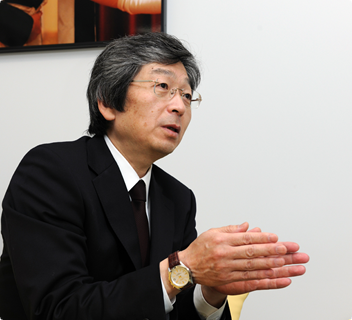Nikon introduced me to optical engineering.
I studied optical engineering after joining Nikon.
Tell us your motives for entering Nikon.
I had known the name of Nikon since my junior high school days as I was a great fan of cameras and astronomical telescopes. My image of Nikon was that the company only dealt with expensive high-class products, and so never thought that it would enter my life. But chances were that Nikon Oi Plant was close to my university. That’s why I applied for a position with the company at the time. So it is completely by chance that I am here today.
Your initial assignment was in the optical department?
Yes, it was. That department was where they made designs of optical systems for surveying equipment and microscopes. I was assigned to design lenses there. I waited for some time, and then received my first job, which was to increase the functions of measurement software applied for use with a 3D coordinate measuring machine — which Nikon imported for marketing in Japan. Thus, my first project at Nikon had no relation to optics.
Your achievements are many, including the development of automatic lens designing software — most frequently used at Nikon.
The automatic lens designing software, employing the rank-down method, acquired quite a good reputation, and became the software most regularly used at Nikon. Other software I developed for Nikon includes those for camera AF optical system design, magneto-optical-disk signal analysis, waveguide* device analysis and near-field optical-microscope signal analysis.
Your developments attracted quite a lot of attention.
The mode interference microscope, which we developed by applying a waveguide, was selected as a Noteworthy Invention by the Science and Technology Agency (now, the Ministry of Education, Culture, Sports, Science and Technology). In addition, the development of nonlinear multiplex exposure design for IC steppers was featured on the front page of the Nikkan Kogyo Shimbun. This was quite a happy surprise.
- *Waveguide: An optical transmission path created by using materials having certain optical characteristics.
Research meetings at the University of Tokyo greatly stimulated the desire to study and learn.
Did you study optics, particularly optical engineering, at your university?
I studied nuclear physics at my university. I started the study of optics after I joined Nikon. Several years later, I also joined the Tuesday Seminar, which exerted a great influence over me at the time. Participants were asked to give a lecture about their own area of expertise every Tuesday.

What impression did this make on you?
I was surprised to hear the very high-level questions that members asked.
The topic of the day would often be about something they’d heard of for the first time that day, but they grasped the essence in a short time and asked precise questions. I was extremely impressed with the intelligence of the questions. I remember that I studied hard back at home so I would be able to follow the topics of the meetings.
